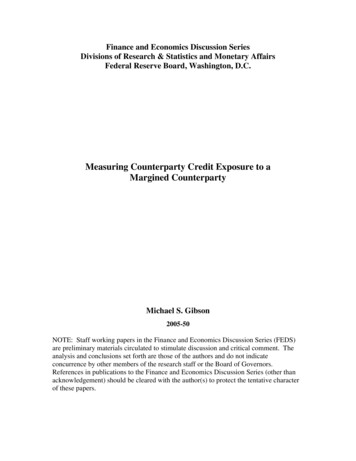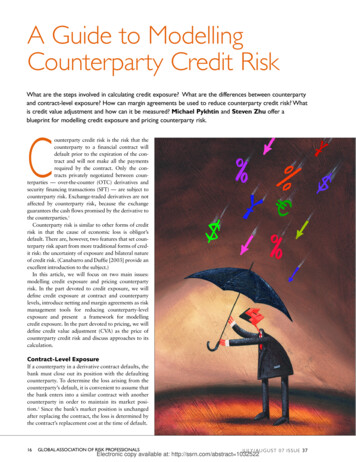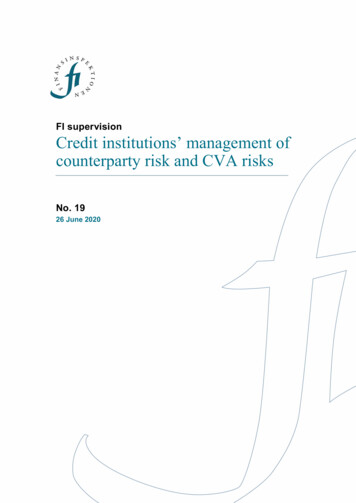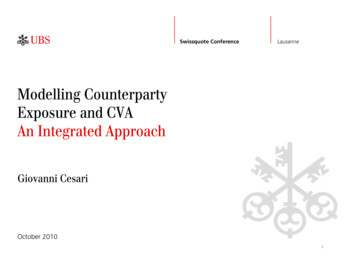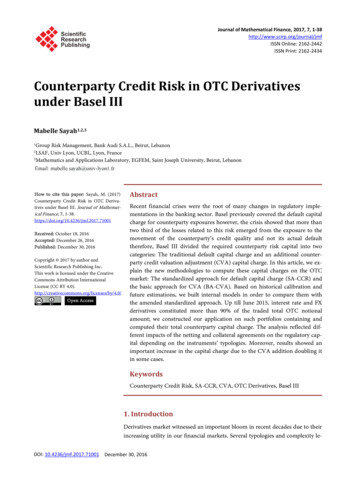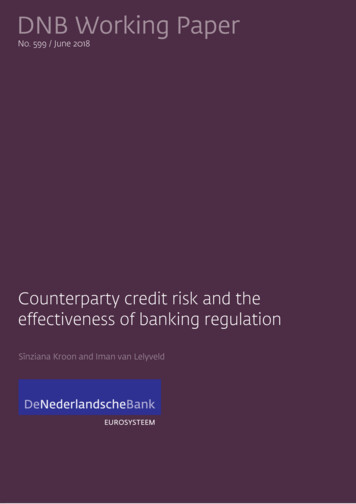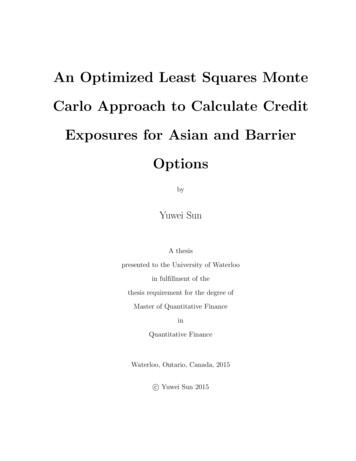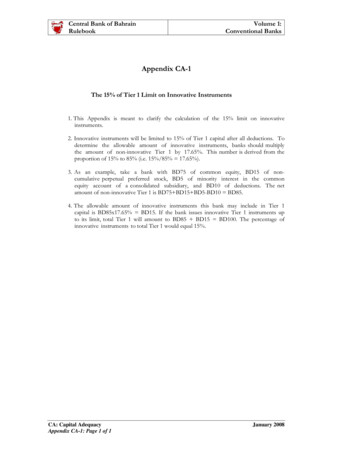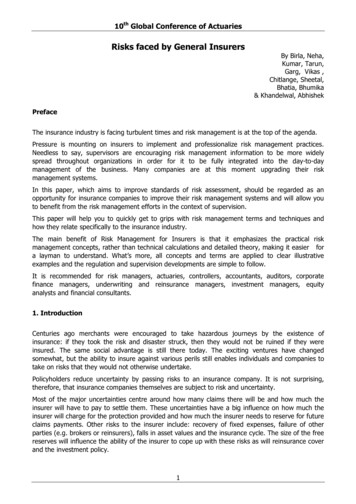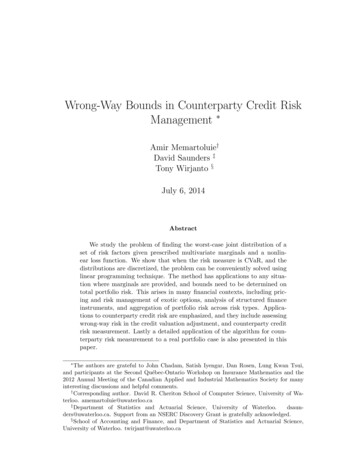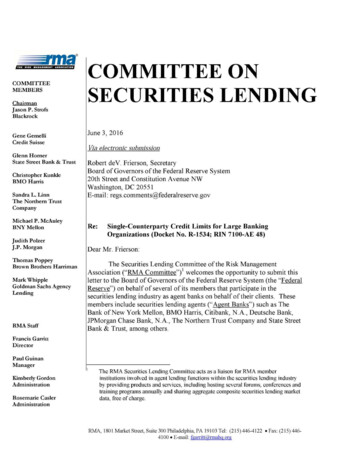
Transcription
THI!#US«au.H GeMl!HT ssoc1 TIONCOMMilTEEMEMBERSChairmanJason P. StrofsBlackrockGene GemelliCredit SuisseCOMMITTEE ONSECURITIES LENDINGJune 3, 2016Via electronic submissionGlenn HornerState Street Bank & TrustChristopher KunkleBMO HarrisSandra L. LinnThe Northern TrustCompanyMichael P. McAuleyBNYMellonJudith PolzerJ.P. MorganThomas PoppeyBrown Brothers HarrimanMark WhippleGoldman Sachs AgencyLendingRMAStaffRobert deV. Frierson, SecretaryBoard of Governors of the Federal Reserve System20th Street and Constitution Avenue NWWashington, DC 20551E-mail: arty Credit Limits for Large BankingOrganizations (Docket No. R-1534; RIN 7100-AE 48)Dear Mr. Frierson:The Securities Lending Committee of the Risk Management1Association ("RMA Committee") welcomes the opportunity to submit thisletter to the Board of Governors of the Federal Reserve System (the "FederalReserve") on behalf of several of its members that participate in thesecurities lending industry as agent banks on behalf of their clients. Thesemembers include securities lending agents ("Agent Banks") such as TheBank ofNew York Mellon, BMO Harris, Citibank, N.A. , Deutsche Bank,JPMorgan Chase Bank, N.A. , The Northern Trust Company and State StreetBank & Trust, among others.Francis GarrittDirectorPaul GuinanManagerKimberly GordonAdministrationRosemarie CaslerAdministrationThe RMA Securities Lending Committee acts as a liaison for RMA memberinstitutions involved in agent lending fimctions within the securities lending industryby providing products and services, including hosting several forums, conferences andtraining programs mmually and sharing aggregate composite securities lending marketdata, free of charge.RMA, 180 1 Market Street, Suite 300 Philadelphia, PA 19103 Tel: (215) 446-4122 Fax: (215) 446 4100 E-mail: fgaITitt@rmahq.org
June 3, 2016Page 2This letter addresses the Federal Reserve's re-proposal ofthe single-counterpartycredit limits ("SCCL") mandated by Section 165(e) of the Dodd-Frank Wall StreetReform and Consumer Protection Act (the "Re-Proposal"). 2 The Re-Proposal impactsAgent Banks as a result of the borrower default indemnification that they provide theirlending clients as a part of the Agent Banks' agency securities lending programs. TheRMA Committee believes that the Federal Reserve could pursue the regulatory goalsunderlying the Re-Proposal with less complexity and less opportunity for regulatoryarbitrage if the SCCL adopted either the methodologies described in this letter or thosethat are already in use for the calculation of similar exposures.The RMA Committee is concerned that the Re-Proposal continues to significantlyoverstate actual exposures relating to the borrower default indemnification. Under anapplication of the Re-Proposal as currently drafted, such an overstatement of exposurewould cause Agent Banks to curtail significantly transactions with large counterpartiesand collateral issuers. Such restrictions could severely impair long-established banksecurities lending agent activities as well as other activities of many lending clients, whilealso promoting regulatory arbitrage and impacting securities market liquidity by reducingthe volume of securities available for loan.This letter discusses why the measure for exposure set forth in the Re-Proposalpresents significant issues both from a conceptual standpoint and as a practical matter,and provides several concrete alternatives to the proposed measure.I.Executive Summary The Federal Reserve should adopt the Basel Committee on Banking Supervision(the "Basel Committee")'s proposed methodology for measuring exposures fromrepo-style transactions. We believe that the Basel Committee' s proposal (the"Basel Proposal") improves upon the methodology in the Re-Proposal byallowing increased recognition of: (i) correlations between long and shortpositions and (ii) the risk mitigating benefits of diversification. We also believethat the Basel Proposal would be simple to implement, contrary to what theFederal Reserve suggests. Finally, use of the Basel Proposal would promoteglobal, consistency and should reduce opportunities for cross-product and cross border arbitrage. In contrast, the approach set forth in the Re-Proposal isfundamentally flawed, conceptually unsound, promotes poor risk managementpractices, creates significant arbitrage opportunities between physical andsynthetic securities lending, negatively impacts market liquidity and mayeliminate a low-risk stream of revenue for pensioners, shareholders and retailinvestors.See Federal Reserve, Single-Counterparty Credit Limits for Large Banking Organizations, 81 Fed.Reg. 14,328 (Mar. 16, 2016).RMA, 180 1 Market Street, Suite 300 Philadelphia, PA 19103 Tel: (2 15) 446-4 122 Fax: (2 15) 446-4100 E-mail:fga rritt@mrnJ1g.org
June 3, 2016Page 3 The Federal Reserve should allow a more flexible range of approaches formeasuring exposures until such time as it decides to adopt the Basel Proposal (ora similar Basel Committee proposal) for the purposes of the Federal Reserve' sregulatory capital rules. In particular, the RMA Committee requests that, withrespect to "repo-style transactions" subject to bilateral netting agreements,covered companies (including Agent Banks) be permitted to apply anymethodology that the covered company is permitted to use under the FederalReserve ' s risk-based capital rules or, subject to approval by the Federal Reserve, amethodology used by the covered company for internal risk managementpurposes. The definition of" eligible collateral" should be made consistent with thedefinition of"financial collateral" under the Federal Reserve's regulatory capitalrules. The list of"eligible collateral" set forth in the Re-Proposal is overlynarrow, and should be expanded to include gold bullion, private-label mortgage or asset-backed securities and money market fund shares or other mutual fundshares (for which shares are publicly quoted daily).II.Background on Agency Securities Lending3Institutions that participate in securities lending transactions support capitalmarkets activities and facilitate trade settlement. 4 By increasing the supply andavailability of securities for these and other market activities, securities lending improvesglobal market liquidity. A joint report produced by The International Organization ofSecurities Commissions concluded that "securities lending is an integral component ofnearly all active securities markets," that "[t]he securities-driven market increases theliquidity of securities markets by providing a means for participants to borrow securitieson a temporary basis" and that "[t]he growth of securities lending is attributable in largemeasure to the positive effects securities lending has had on both investment activity andsecurities settlement arrangements." 5For a more detailed description of the components of indemnified agency securities lendingtransactions, see Appendix II.The discussion and analysis in this comment Jetter focus on the securities lending industry andindemnified agency securities lending in particular. Nonetheless, the analysis contained hereinapplies generally to al1 types of repo-style transactions conducted on both a principal and agencybasis, including repurchase, reverse repurchase agreements, securities lending and borrowingtransactions. Thus, to the extent applicable, references in this comment letter to "securities lendingtransactions" may be read to include other repo-style transactions; alJ proposals set forth in thisconunent letter apply equalJy to aH types of repo-styJe transactions.See, e.g., International Organization of Securities Conunissions, Securities Lending Transactions:Market Development and Jmplications 55 (July 1999), available athttp://www.bis.org/cpmi/publ/d32.pdf.RMA, 1801 Market Street, Suite 300 Philadelphia, PA 19103 Tel: (2 15) 446-4 122 Fax: (2 15) 446-4100 E-mail:fga rritt@mrnJ1g.org
June 3, 2016Page 4Agency securities lending services and the related provision of borrower defaultindemnifications are industry standard market practices at Agent Banks. These serviceshave been a customary outgrowth of Agent Banks' custody and related activities fordecades, and have long been regulated, examined and treated by regulators as traditionalbanking services. 6 Members of the RMA Committee provide custodial and securitieslending services both in and outside of the United States; Agent Banks acting assecurities lending intermediaries include many of the largest financial institutions in theworld.As discussed in greater detail in Section III below, the implementation ofthe Re Proposal as currently drafted would place significant limitations on U.S. Agent Banks'indemnified agency securities lending programs that are not commensurate with therelatively low-risk profile of these activities. In an informal survey ofRMA membersinvolved in the drafting of this letter: (i) many members with the largest securitieslending operations have never experienced any losses as a result of borrower-defaultindemnification and (ii) no members have incurred material losses as a result of theindemnification. These limitations likely would lead many lending clients to withdrawfrom the U.S . agency lending market and terminate their programs, or move towardssynthetic alternatives.As discussed in Section IV below, a significant decrease in volume of securitiesavailable for loan would impair broader access to securities, driving down liquidity and inturn, impeding price discovery in the U.S . and global securities markets. This potentiallycould create disruptions in the capital markets at the very time market liquidity is criticalto promote continued economic recovery in the global marketplace. It would bereasonable to conclude that the disruptions to liquidity from the absence of securities forloan would be most acutely felt during those times of financial distress that the Re Proposal is intended to prevent.ID.Specific Concerns and RecommendationsA.Recommendation: The Federal Reserve should adopt the BaselCommittee's proposed methodology for measuring exposures fromrepo-style transactions.The Re-Proposal would require an Agent Bank to calculate its net credit exposurefor securities lending transactions with a counterparty subject to a bilateral nettingagreement by using the collateral haircut approach referenced in the Federal Reserve'sRegulation Q, pursuant to which the Agent Bank would be required to use standard6See, e.g., Securities Lending, Federal Financial Institutions Examination Council, Supervisory Policy(1985).RMA, 180 1 Market Street, Suite 300 Philadelphia, PA 19103 Tel: (2 15) 446-4 122 Fax: (2 15) 446-4100 E-mail:fga rritt@mrnJ1g.org
June 3, 2016Page 57supervisory haircuts (the "Collateral Haircut Approach"). The Re-Proposal would notpermit Agent Banks to measure such exposure using any of the other methods availableunder Regulation Q, including the internal models or simple VaR methodologies. 8Question 20 of the Re-Proposal asks whether the Federal Reserve shouldconsider alternative approaches to measuring the net credit exposure from repo-styletransactions.9 The RMA Committee respectfully submits that, particularly for long proven safe and sound activities like agency securities lending, the Collateral HaircutApproach is overly conservative and grossly overstates the risks attributable to agencysecurities lending transactions. As noted in Section II above, the RMA membersinvolved in the drafting of this letter, representing a large majority by value of all agencysecurities lending transactions, have never incurred material losses as a result of theirindemnification.The RMA Committee proposes that the Collateral Haircut Approach therefore bereplaced by the methodology proposed by the Basel Committee in its December 2015consultation on "Revisions to the Standardised Approach for credit risk," as discussed inmore detail in Section III.A.2 below. 10 Although the Federal Reserve has suggested thatthe Basel Proposal would " increase the complexity of the framework" and " potentiallymake the framework susceptible to arbitrage," the RMA Committee respectfully submitsthat, to the contrary, the Basel Proposal would be a simple and transparent alternative tothe Collateral Haircut Approach that would leave very little room for arbitrage. In fact,adopting the Basel Proposal would promote international consistency and reduce theopportunities for cross-border regulatory arbitrage.1.The Collateral Haircut Approach is overly conservative and notsufficiently risk sensitive.The Collateral Haircut Approach relies on a table of supervisory haircuts that varywith a number of factors, including the credit rating of the instrument, the identity of theissuer and the instrument's residual maturity. The table of supervisory haircuts andaccompanying formula, however, lack both granularity and risk-sensitivity, in particular,See Proposal § 252.74(b).See 12 C.F.R. 21 7.132(b)(3), (d).9See Federal Reserve, Single-Counterparty Credit Limits for Large Banking Organizations, 81 Fed.Reg. 14,328, 14,338 (Mar. 16, 2016).10See Basel Committee on Banking Supervision, Revisions to the Standardised Approach for credit risk(December 10, 2015), available athttp://www.bis.org/bcbs/publ/d347.pdf. The RMA Cmmuitteewould also consider supporting whichever approach the Basel Committee decides to adopt in its finalrevisions to its Standardised Approach for credit risk.RMA, 180 1 Market Street, Suite 300 Philadelphia, PA 19103 Tel: (2 15) 446-4 122 Fax: (2 15) 446-4100 E-mail:fga rritt@mrnJ1g.org
June 3, 2016Page 6by failing to take into account the effects of correlation between the securities loaned andcollateral posted that are likely to exhibit themselves during times of stress. Instead, theCollateral Haircut Approach focuses solely on the assumed volatility of each componentof the exposure in isolation, and implies that the assets on loan are perfectly negativelycorrelated with the assets taken as collateral, specifically by requiring bankingorganizations to take a fixed negative haircut on the value of the loan exposure whiletaking a fixed positive haircut on the value of the collateral.It would be extremely unrealistic to assume that the price of the security lentwould always rise simultaneously with a fall in the price of the collateral during a time ofstress, and for each instrument, always by the same fixed percentage. For example, alarge systemic shock may cause prices across many asset classes to fall, causing the valueof both securities loaned and collateral posted to fall simultaneously. Furthermore, thetable of haircuts does not recognize the possibility of a " flight to quality" during times ofstress, where certain classes of securities (e.g., equities and corporate bonds lent) wouldbe expected to fall in price while the price of "safe" assets (e.g., U.S. Treasuriescollateral) would be expected to rise.Furthermore, the Collateral Haircut Approach assumes a perfect positivecorrelation among assets within an Agent Bank' s securities loan portfolio and similarlyamong assets in its collateral portfolio by assuming the same haircut for asset classesregardless of the composition of a portfolio and by assuming that the securities loanedwill always increase in price while collateral will always decrease in price. Thisassumption fails to recognize the risk-mitigating benefits provided by portfoliodiversification. In the same way that it would be unreasonable to assume that allsecurities lent and all collateral posted are perfectly negatively correlated across all assetclasses, it would be equally inappropriate to assume that the price of assets on the sameside of an exposure would move perfectly in sync with each other. In reality, an AgentBank that maintains a well-diversified portfolio of loaned securities (or of collateral) isprotected against shocks to specific asset classes. By failing to recognize the benefits ofsuch diversification, the Collateral Haircut Approach fails to encourage Agent Banks topursue a safe-and-sound practice. This overstatement of risk effectively eliminates alarge incentive for Agent Banks to enter into qualifying master netting agreements withrespect to repo-style transactions.As an example of the overstatement of exposure risk under an application of theCollateral Haircut Approach, an Agent Bank may lend (1) 100 million ofIBM and 100million of Apple against 204 million in cash collateral to one broker and (2) 100million of IBM and take 102 million of Apple as collateral with another broker.11 TheAgent Bank has twice as much notional exposure and a great deal more market exposure11We assume, for the purposes of the analysis, that each set of transactions qualify as "repo-styletransactions" conducted under a "qualifying master netting agreement." See, e.g., 12 C.F.R. 217.2.RMA, 180 1 Market Street, Suite 300 Philadelphia, PA 19103 Tel: (2 15) 446-4 122 Fax: (2 15) 446-4100 E-mail:fga rritt@mrnJ1g.org
June 3, 2016Page 7to the first broker. In terms of idiosyncratic risk, the Agent Bank would have similarexposures to both brokers. However, under the Re-Proposal, the Agent Bank must recorda larger net credit exposure to the second broker. In particular, the net credit exposureamount to the first broker would be approximately 17.2 million, while the net exposureamount to the second broker would be approximately 19.4 million. More details on thecalculations in this example can be found in Appendix I.This difference is attributable largely to the methodology' s assumption of aperfect negative correlation between lent securities and collateral in the secondtransaction. For loaned securities and collateral from different asset classes, such asequities versus fixed income, a case may be made for such a treatment. However, withinthe same asset class (i.e., equities against equities) this treatment is overly punitive andwithout merit. In particular, an exposure measure based on these assumptions isparticularly ill-equipped to deal with a rising interest rate environment in which equity for-equity loans would be more safely collateralized than loans secured by U.S . Treasurysecurities.The result is a gross overstatement of the risk associated with such activity, andwould have the effect of inappropriately limiting Agent Banks' ability to lend theirlending clients' assets to high-quality, high-volume counterparties under theirindemnified agency securities lending programs. Ultimately, as discussed above, thiscould lead to a reduced securities lending supply, reducing returns to lending clients andmore generally restricting liquidity in the market.2.The Basel Proposal is more risk sensitive, appropriatelyconservative, simple to implement and fully transparent. 12The Basel Proposal addresses both concerns highlighted above in Section III.A. I,that the Collateral Haircut Approach does not allow for appropriate recognition ofcorrelations between securities lent and collateral taken, and that it does not allow forrecognition of diversification in loan or collateral portfolios. The Basel Proposalattempts to address the first point by incorporating partial netting of loan and collateralhaircut amounts within the exposure calculation. The Basel methodology preventsexposures from being netted down entirely, increasing the credibility of the approach.The Basel Proposal addresses the latter concern by scaling down a portion of theexposure for portfolios with a large number of (diversified) positions. AJthough theBasel Proposal is not as risk sensitive as the internal models or simple VaRmethodologies, the RMA Committee believes that it represents a significant improvement12Regardless of whether the Basel Conunittee decides to adopt the Basel Proposal, the RMA Conunitteewould support an approach that pennitted recognition of correlation between securities lent andcollateral posted and that recognized the potential for Agent Banks to reduce their potential exposureat default by diversifying the portfolio of securities loaned or collateral accepted.RMA, 1801 Market Street, Suite 300 Philadelphia, PA 19103 Tel: (215) 446-4 122 Fax: (2 15) 446-4100 E-mail:fga rritt@mrnJ1g.org
June 3, 2016Page 8over the Collateral Haircut Approach. A mathematical description ofthe Basel Proposalcan be found in Appendix I.To illustrate the improved risk sensitivity of the Basel Proposal, consider theexample in Section III.A. I above. Under the Basel Proposal, the net credit exposureamount to the borrower to whom the Agent Bank lends 100 million of IBM and 100million of Apple against 204 million in cash collateral would be approximately 13.5million whereas the net credit exposure to the borrower to whom the Agent Bank lends 100 million oflBM against 102 million of Apple would be approximately 7.2 million.The Agent Bank' s credit exposure to the second broker therefore would be lower than itsexposure to the first broker, consistent with the economic reality of the transaction. Notethat this difference is attributable to the fact that the Basel Proposal permits the partialnetting of haircut amounts and recognizes the diversity of positions within a netting set.More details on the calculations in this example can be found in Appendix I.In light of the foregoing, the RMA Committee disagrees that the Basel Proposalwould "increase the complexity of the framework" and "potentially make the frameworksusceptible to arbitrage." Fundamentally, the Basel Proposal represents a simplemodification to one component of the Collateral Haircut Approach. As modified, theexposure methodology would remain an extremely straightforward computation, basedlargely on currently available data and supervisory inputs supplied by the FederalReserve, and would resemble the "current exposure methodology" (the "CEM") currentlyimRlemented to measure derivatives exposures under the Federal Reserve's RegulationQ. 3 It is important to highlight that the Basel Proposal would not require any additionaldata from either Agent Banks or the regulators to implement; it would leverage data thatis already used in the Collateral Haircut Approach (except data on the number ofexposures in a netting set, which Agent Banks collect as a part of their internal riskmanagement). Given the strong similarity, the RMA Committee submits that the BaselProposal would not be any more difficult to implement than the CEM.By virtue of the Basel Proposal's simplicity and the transparency of its inputs, it isdifficult to see how this framework would be susceptible to arbitrage to a greater extentthan the Collateral Haircut Approach, as the Re-Proposal suggests. In contrast, allowingdisparate capital treatment between traditional, physical securities lending and itssynthetic equivalents could in fact motivate banks to find opportunities for arbitragethrough alternative structures. In particular, the Re-Proposal appears to incentivize AgentBanks and borrowers to move the securities lending market to synthetic equivalents.Although the vast majority of securities lending transactions involve the physical deliveryof securities, the RMA Committee notes that, in recent years, brokers have increased their13See, e.g., 12 C.F.R. 2 l 7.34(a).RMA, 180 1 Market Street, Suite 300 Philadelphia, PA 19103 Tel: (2 15) 446-4 122 Fax: (2 15) 446-4100 E-mail:fga rritt@mrnJ1g.org
June 3, 2016Page 9offerings of economically equivalent synthetic alternatives to traditional, physical14securities lending.B.Recommendation: The Federal Reserve should allow a more flexiblerange of approaches for measuring exposures until such time as itdecides to adopt the Basel Proposal (or a similar Basel Committeeproposal) for the purposes of the Federal Reserve's regulatory capitalrules.As discussed above in Section III.A, the Re-Proposal would require Agent Banksto use the Collateral Haircut Approach to measure their credit exposure for agencysecurities lending transactions. In contrast, the Re-Proposal would permit coveredcompanies to measure their exposures from derivatives subject to qualifying masternetting agreements using any methodology that the covered company is permitted to useunder the Federal Reserve's risk-based capital rules. In other words, if a coveredcompany were permitted to use the internal models methodology to calculate its exposureto derivatives under Regulation Q, it would be able to use the internal modelsmethodology to calculate its credit exposure under the Re-Proposal.The RMA Committee requests that, until the Federal Reserve decides whether toadopt the Basel Proposal (or whichever methodology the Basel Committee adopts in itsfinal framework) for the purposes of its regulatory capital rules, that covered companies(including Agent Banks) be permitted to use a range of approaches simil ar to theapproach that the Federal Reserve has proposed for calculating gross credit exposures forderivatives.In particular, the RMA Committee requests that, with respect to "repo-styletransactions" subject to bilateral netting agreements, covered companies (including AgentBanks) be permitted to apply any methodology that the covered company is permitted touse under the Federal Reserve's risk-based capital rules or, subject to approval by theFederal Reserve, a methodology used by the covered company for internal risk15management purposes. Allowing for a range of approaches would bring themeasurement of exposures for repo-style transactions in line with the methodology for16derivatives and thereby discourage regulatory arbitrage.14For example, many brokers now offer synthetic products that are economically equivalent totraditional, physical securities lending using derivatives, such as total return swaps or contracts fordifference.15Allowing covered companies to apply any method that the covered company employs for riskmanagement purposes, with Federal Reserve approval, would help prevent disparate capital treatmentof the same transactions conducted at differently sized banks.16Aligning the approaches also would discourage arbitrage by ensuring that cash transactions and theirsynthetic equivalents are subject to similar credit limits.RMA, 1801 Market Street, Suite 300 Philadelphia, PA 19103 Tel: (215) 446-4 122 Fax: (2 15) 446-4100 E-mail:fga rritt@mrnJ1g.org
June 3, 2016Page 10C.Recommendation: The definition of "eligible collateral" should bemade consistent with the definition of "financial collateral" under theFederal Reserve's regulatory capital rules.As discussed above, the Re-Proposal would only permit covered companies torecognize the risk mitigating benefits of"eligible collateral," defined to include cash ondeposit with the covered company (including cash held for the covered company by athird-party custodian or trustee), investment grade debt (other than mortgage- or asset backed securities and resecuritization securities, unless issued by a U.S. government sponsored enterprise) that are bank-eligible investments, publicly traded equities and17publicly traded convertible bonds.Notably, the range of permissible collateral under the Re-Proposal would besignificantly narrower than what constitutes "financial collateral" under the FederalReserve 's capital rules. In particular, the Re-Proposal would not permit gold bullion,private-label mortgage- or asset-backed securities, money market fund shares or othermutual fund shares (for which shares are publicly quoted daily) to serve as "eligiblecollateral," even though each such instrument could qualify as "financial collateral" forthe purposes of the Federal Reserve's Regulation Q.Question 21 of the Re-Proposal asks whether the list of "eligible collateral"18should be broadened or narrowed. We urge the Federal Reserve to broaden the list toalign the definition of"eligible collateral" for the purposes of the single-counterpartycredit limits with the definition of "financial collateral" under the Federal Reserve' sRegulation Q. We see merit in aligning the exposure measure under the Re-Proposalwith the corresponding exposure measure under its regulatory capital rules, and wouldurge the Federal Reserve to adopt those measures wholesale, rather than piecemeal.Aligning the two definitions would achieve consistency and harmony with the capitalrules, and would prevent the same transaction from being measured in different ways forthe purposes of rules that both deal with credit exposures.IV.Impact of Excessively Limiting Agency Securities LendingAs discussed below, implementation of the single-counterparty concentrationlimits under the Re-Proposal as currently drafted has the potential to materially impactnot only Agent Banks, but also their lending clients and the financial markets at large.1.Impact on Agent Banks and lending clients.17See Proposal§ 252.7l(k), 252.74(b)(2).18See Federal Reserve, Single-Counterparty Credit Limits for Large Banking Organizations, 81 Fed.Reg. 14,328, 14,339 (Mar. 16, 2016).RMA, 180 1 Market Street, Suite 300 Philadelphia, PA 19103 Tel: (2 15) 446-4 122 Fax: (2 15) 446-4100 E-mail:fga rritt@mrnJ1g.org
June 3, 2016Page 11If the final regulations implementing Section 165(e) act to limit large U.S. banks 'and financial institutions ' ability to facilitate certain securities lending transactions with aborrower default indemnification, U.S. Agent Banks would be put at a significantcompetitive disadvantage against both non-bank entities and non-US . institutions, whichare not subject to such restrictions, creating opportunity for regulatory arbitrage. Adecline in the securities lending business at the largest U.S . custody banks also wouldlikely lead to a decline in revenues in other businesses at these banks as well, as thelargest securities lending clients may be enticed to move other parts oftheir bankingrelationships (such as custodial and related services) elsewhere (including non-US .Agent Banks and foreign non-bank ent
The RMA Securities Lending Committee acts as a liaison for RMA member institutions involved in agent lending fimctions within the securities lending industry by providing products and services, including hosting several forums, conferences and training programs mmually and sharing aggregate composite securities lending market data, free of charge.
